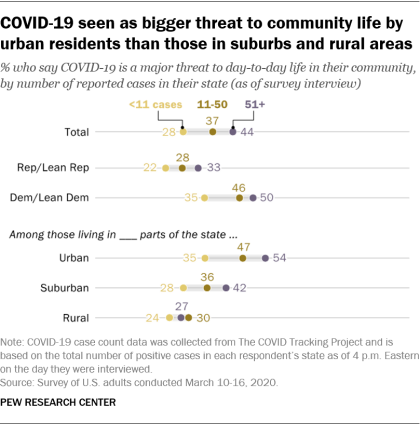The COVID-19 outbreak has already led to large-scale closures of schools, workplaces and public gathering places across the United States, and “social distancing” measures recommended by the Centers for Disease Control and Prevention are likely to lead to further disruptions.

Yet the thousands of cases of the new coronavirus are not evenly dispersed across the country. And the people most likely to say the disease threatens “day-to-day life” in their communities are those living in urban areas in states that have seen relatively high numbers of cases.
Overall, 36% of Americans say the coronavirus outbreak is a major threat to day-to-day life in their community, according to a new survey conducted as part of Pew Research Center’s Election News Pathways project.
How we did this
Pew Research Center conducted this study to understand how Americans in different parts of the country are responding to the new coronavirus outbreak. For this analysis, we surveyed 8,914 U.S. adults in March 2020. Everyone who took part is a member of Pew Research Center’s American Trends Panel (ATP), an online survey panel that is recruited through national, random sampling of residential addresses. This way nearly all U.S. adults have a chance of selection. The survey is weighted to be representative of the U.S. adult population by gender, race, ethnicity, partisan affiliation, education and other categories. Read more about the ATP’s methodology.
In addition to using survey data from the ATP, this analysis uses data from the COVID Tracking Project (a collaboration between journalists at several organizations to track the spread of the disease in real time).
Here are the questions used for the report, along with responses, and its methodology.
As with perceptions of other threats from the coronavirus, views of the impact of the disease are divided by partisanship. Among Democrats and Democratic-leaning independents, 44% say the coronavirus outbreak is a major threat to community life, compared with 26% of Republicans and Republican leaners.
Yet both Republicans and Democrats living in the hardest-hit states (including Washington, New York and California) are more likely than their counterparts in less affected states to say the coronavirus is a major threat to community life. However, Republicans living in the hardest-hit states are about as likely as Democrats living in the least hard-hit states to say that coronavirus is a major threat to day-to-day life in their community (33% of Republicans in hard-hit states compared with 35% of Democrats in states with fewer confirmed cases).
Notably, there also are differences in views of people living in different types of communities within hard-hit and less hard-hit states. A 54% majority of urban residents in the states that have seen the most COVID-19 cases view the disease as a major threat to day-to-day life in their communities. That compares with 42% of those living in suburbs and just 27% of rural residents in the same states. This pattern holds in less affected states as well, with urban residents more likely than those living in other types of communities to regard the outbreak of the coronavirus as a major threat.
Note: Here are the questions used for the report, along with responses, and its methodology.
